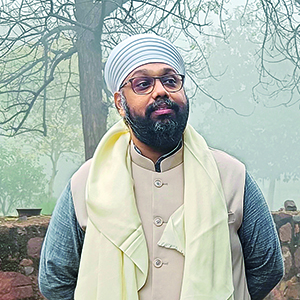
Enthusiastic participants exploring the Munirka Baoli during the heritage walk
Take a walk into Delhi’s fabulous water rich past
Sukanya Sharma
The walk was organized by Tales of City in collaboration with Niyogi Books, publisher of Delhi Heritage — Top 10 Baolis by Vikramjit Singh Rooprai, who led the walk. Tales of City is a travel and heritage enterprise that organizes curated walks across major Indian cities, offering a blend of history, art, tradition and interactions to present the true essence of a city to its people.
Rooprai is an ex-software engineer by profession and a heritage activist and educator by choice. His passion for his new-found career is palpable. While he devotes much of his time to exploring and writing on facets of Delhi’s heritage, he is involved with educational institutions through his organization, Heritageshaala, which sets up heritage labs in schools across India to develop novel methods of pedagogy through the use of history. “I train teachers on how to use history to teach subjects like science. I’d call it applied education,” he explains.
 |
| Vikramjit Singh Rooprai |
The agenda for the morning began with an informal introductory chat as Rooprai walked us through his book and the extensive research he’d undertaken for four years. Alongside, he narrated anecdotes which helped break the ice. He told us how the book is close to his heart. He reminisced about how he went back and forth with his research before condensing it into the slim volume we were all holding.
Delhi is still home to 32 baolis, out of which 14 are accessible. Four of these are in use even today with water being pumped out regularly. These are at the Red Fort, Old Fort, Feroz Shah Kotla and Banjaron ki Baoli. The baolis of the Nizamuddin Dargah and Gandhak are believed to be holy so people often take a dip in them despite hygiene issues related to stagnant water, explains the author.
“It took me the longest time to locate this Munirka Baoli.” He catches us off-guard. How could this structure be buried in oblivion? The name gives it away. Back in the 1950s, a portion of land was taken from Munirka to form Rama Krishna (RK) Puram and this is why the baoli now falls in Sector 5 of this colony.
Measuring 100 feet by 38 feet with a well to the south, this is one of Delhi’s smaller baolis. The complex, also known as Wazirpur Gumbad, dates back to the Lodhi era. It houses five tombs, a prayer wall (Qanati Masjid) and a stepwell. The tombs are of unknown people so local devotees refer to them as ‘Pir Baba’. The most striking feature is that it is tucked between a modern-day gurudwara and a temple on either side — a symbol of peaceful coexistence in a world fraught with communal divisiveness.
While exploring the stairs down this intricately built structure, we also learnt that some of the practices we now refer to as superstitions (such as not washing one’s hair on Tuesdays) can be traced to these stepwells. Since the soap used for clothes was harsh on the skin and amla shikakai used to wash hair was damaging for clothes, certain days were earmarked for washing hair and others for clothes to suit adequate use of the water stored in the stepwells.
We asked if baolis can be revived. Rooprai said it would be difficult but not impossible. A real effort at reviving this system would involve draining out the water in a baoli, cleaning its bed and directing rainwater into it for many monsoons.
The ancient water system is challenged because of Delhi’s leaky sewerage system. For that an underground water decontamination plan spanning the whole city is required. Despite these roadblocks, he insists this should be made a priority. Logistics and political will are key elements. “Vikramjit’s proposal to use the stepwells as aquifers and divert rainwater into them might be one way of partially reversing the unending cycle of continuous exploitation of water,” writes historian Sohail Hashmi in the foreword to the book.
Even though the walk covered only the Munirka Baoli, it sparked animated discussions about the other, more famous, baolis in Delhi, especially Rajon ki Baoli and Ugrasen ki Baoli, both of which feature in the book. And so, the walk extended beyond the confines of this complex that stands tucked away in this quiet neighbourhood.
With the tour of the complex and stepwell behind us, the conversation shifted towards the realisation that much of our history may have been lost in translation or coloured by colonial prejudice. This sparked a discussion that led to a nugget of history from the Kuka community (now known as the Namdhari Sikhs), to which Rooprai belongs.
He proudly explained how the Kuka movement was one of the first instances of non-cooperation against the British. In fact, there are still some traditional Kuka families that refrain from using tap water and have wells in their homes even today. They still boycott anything invented by the British. This incidentally leads us to the author’s next book, in the pipeline, which he hopes to begin working on this year.
The uniquely curated walk was a holistic experience that piqued interest in Delhi’s myriad heritage sites.
Comments
Currently there are no Comments. Be first to write a comment!



